GoHorseShow.com in partnership with SmartPak are pleased to continue the highly popular column, GoSmart with Charlie and Jason. Team SmartPak riders, Charlie Cole and Jason Martin have achieved success beyond compare. Since founding Highpoint Performance Horses in 1992, they have trained over 150 World Champions and 250 Congress Champions. Exclusive to GoHorseShow.com, GoSmart with Charlie and Jason will give you access to Charlie and Jason and the secrets to their success like never before. Our next article involves going down the line in the Western Riding.
Amazingly, from 2005 through 2014, a total of 10 years, a horse shown and trained by Charlie Cole or Jason Martin has won the Senior Western Riding class at the AQHA World Championship show every single year. And if that wasn’t impressive enough, for the past seven years, Charlie and Jason trained and showed the Reserve World Champion as well. This is an incredible accomplishment, especially given that western riding is such a difficult and challenging class. The duo also have two highly successful western riding instructional videos that can be purchased by clicking here.
Jason Martin has over 30 World and Congress Champion titles in Senior Western riding alone. This dominance has earned him the unofficial title of the “Master Showman” of western riding. Martin has shown two of the greatest western riders of all time, Harley D Zip and Vital Signs Are Good. During Highpoint’s 10-year Senior Western Riding winning streak, Martin won eight of the 10 years. Harley D Zip won five of those 10 years.
GoHorseShow spoke with the Western Riding legends Martin and Cole about their approach to the line and had them break it down for us.
Going Down The Line
Western Riding: a class that is marked by fluid, straight lines and flawless lead changes. A class that many love but that many find difficult to master.
The long serpentine line is considered by many to be the most difficult maneuver in Western Riding. In fact, the term “the line” has almost become its own four letter word.
But it doesn’t have to be this way. With careful planning and consideration (and lots of practice) riders can improve their Western Riding scores and their performance on the line.
The Approach
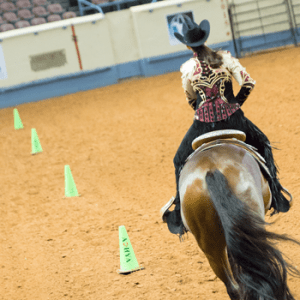 One of the most common mistakes Martin and Cole see in the Western Riding is in a rider’s approach to the line.
One of the most common mistakes Martin and Cole see in the Western Riding is in a rider’s approach to the line.
Charlie Cole’s preference is, “to have four to five strides that are straight before entering the line, definitely no less than three.”
“If you come into the line too tight you then have to worry about steering in addition to getting your [first] lead change,” Jason Martin said, “you’ll find yourself having to turn your horse as you go into the change. It’s a corner you don’t want to cut.”
This strategy should not change, regardless the size of the arena. However, Martin cautions that planning is more critical in a smaller arena. “Some arenas you literally have to get on that wall in order to approach the line straight,” he said.
If you happen to be showing in a larger arena where it is possible to ride more than four to five strides straight before the line, both Martin and Cole advise against it.
“It’s too much extra space,” said Cole, “horses and riders can then start to anticipate too much, four to five strides is really an ideal number.”
Inside the Line
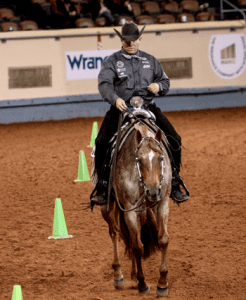 Once your horse’s front legs pass that first cone, you have now entered your line and it’s time to get down to business.
Once your horse’s front legs pass that first cone, you have now entered your line and it’s time to get down to business.
Cole said one of the biggest mistakes he sees people make is waiting too long to move their horse over, or even waiting until after the change to move them over. This mistake impedes on the Western Riding mantra of fluidity and consistency and forces the rider to focus on steering the horse rather than the lead change.
“As soon as my horse’s legs pass that cone, I start asking them to move over,” he said, “they should be moved over and ready to change two to three strides past the first cone tops.”
For Martin, a big mistake he often sees is early changes.
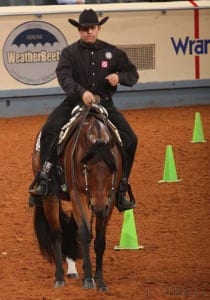 “People often look to the center point between the cones to get their change without realizing they need one more stride to be on top of the center. They change when the horse’s nose is at the center, making them early.”
“People often look to the center point between the cones to get their change without realizing they need one more stride to be on top of the center. They change when the horse’s nose is at the center, making them early.”
Both Martin and Cole advise looking about two feet past the next cone on the side you are aiming for. For example, if you are on the left lead, you will look to the left about two feet ahead of the second cone.
“This allows you to get to where you want to go,” Cole said.
“It also helps to keep you straight so you aren’t weaving in and out of the cones,” Martin added, “if you’re looking down, all of a sudden you look up and you aren’t where you want to be. And once that mistake is made, you spend the rest of your time playing catch up.”
But staying straight in the line isn’t the only challenge riders face. Having a consistent gait through the line (and throughout the entire pattern) is also key to a good ride. Martin and Cole both stressed the importance of finding a pace that both you and your horse are comfortable.
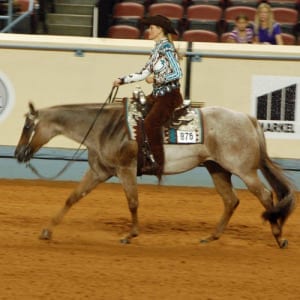 “It always looks better if you are moving forward through the change,” Cole said, “slowing through the change doesn’t look as fluid.”
“It always looks better if you are moving forward through the change,” Cole said, “slowing through the change doesn’t look as fluid.”
“It’s really hard to get a plus on a change if you slow your horse through it,” Martin added, “it takes away from the length of the stride, which affects your score negatively.”
They advise that your longest stride be the one that occurs on the change itself.
“We always accelerate into the change,” Martin said, “then relax for a few strides and accelerate again.”
Speaking of changes, when it comes to hitting your marks down the line, Martin and Cole share the same strategy. They are “counters.” Meaning they count the strides leading up to each change.
“Counting helps my timing,” Martin said, “I change leads on the fourth stride.”
 Cole expounded on the mechanics of how to make this happen.
Cole expounded on the mechanics of how to make this happen.
“When my horse’s front feet are even with the first cone, I start counting on the very next stride,” he said, “I count one, two, three, change. Then I stop counting until my horse’s front feet reach the next cone, then I start over. This allows you to recover if you’re early or late.”
Remember Cole’s advice when it comes to moving your horse over? It comes in handy when coming up with a strategy for your line changes.
“Your horse should be moved over by the time you count one,” he said.
In bigger arenas like at the AQHA World Show, he suggests starting your “one, two, three” count two strides past the first cone.
“You could just count to four and change on five,” he said, “but I find it easier to keep with the one, two, three, change on four method.”
The Departure
Once you’ve made it through your line, you still have a pattern to complete, and the departure is just as important as the approach.
“I like things symmetrical,” said Cole, “so since I like to come in straight for four to five strides, I like to come out of the line straight for four to five strides before making my turn.”
 Martin agrees and added, “Don’t look too far ahead either. Just like if you were stopped at a stop light making a left turn, you don’t look all the way down the street, just to what lane you want to turn into. When you come out of the line, look for the lane you want to turn into.”
Martin agrees and added, “Don’t look too far ahead either. Just like if you were stopped at a stop light making a left turn, you don’t look all the way down the street, just to what lane you want to turn into. When you come out of the line, look for the lane you want to turn into.”
According to Cole, keeping a straight line for four to five strides after the line also helps when it comes to maintaining speed. He also advises to keep in mind that everything that happens after that last line change still goes into your score.
“If you school on your horse or your pace drastically changes, that all goes into your score,” he said. (And it’s not pluses either)
Not Such a Bad Thing…
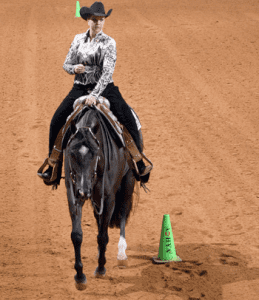 Two “old school” myths about the line were expelled by Martin and Cole: anticipation and over practicing.
Two “old school” myths about the line were expelled by Martin and Cole: anticipation and over practicing.
“You can’t over practice if you’re the one doing the asking,” Cole said. “We practice the line every day.”
“You can’t fake it and get plus one,” added Martin, “it’s about getting horses comfortable with the line. Horses that over anticipate just haven’t had the kinks worked out yet.” In other words, they aren’t comfortable with their job yet.
Martin likened it to a seasoned trail horse on a wheel. Once you get into the wheel, the horse knows its job, they wait for you to bring them out of the wheel, otherwise they just keep going around. It should be the same with Western Riding horses.
“If a horse changes before you actually ask, then you don’t have full control,” he said, “anticipation isn’t a bad thing. It’s a sign the horse knows its job. But you have to control it.”
“Your job is to make them wait,” Cole said.
Bottom line: If you want perfect lines, you have to practice them.







